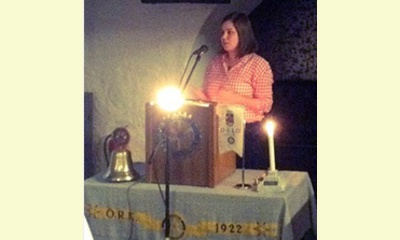|
|
Dialogue for peace in Norway
un article par Ema Talam, a university student from Bosnia and Herzegovina, Rotary Voices
This summer, I was fortunate enough to be selected as one of 16
participants from the Western Balkans to participate in a program
for university students and young professionals, age 20 through 30,
organized by The Rotary Club of Oslo Vest, Norway, and supported
by other Rotary clubs throughout Norway and the Western Balkans. 
Ema Talam addresses Rotary members in Oslo, Norway, during the program on dialogue as a means of promoting peace.
click on photo to enlarge
When I boarded the plane on 15 June, I did not know that this was
going to be one of the most interesting summers of my life. I didn’t
know much about Rotary and I knew only a little about the Young
Friends program I was about to attend. But I can honestly say, after
the seven weeks, I am richer in knowledge, and know more about
human rights and the use of dialogue to build peace.
The first week we spent at Nansen Academy in the small, cozy town
of Lillehammer, Norway. Scholarship recipients from the Western
Balkans met with Peace Scholars from the United States of America.
All of us had an opportunity to interact and learn how dialogue can
be used in conflict and post-conflict areas and how it helps to
bridge ethnic, religious, cultural, national, or any other
dissimilarities between human beings.
The remaining six weeks were spent at the International Summer
School organized by the University of Oslo in Oslo, Norway, where
we joined approximately 550 other students at the school. It was
wonderful meeting young people from all over the world. I have
never encountered such diversity. We had many opportunities for
personal growth, in addition to our lesson plans, and chances to see
other important cities in Norway like Fredrikstad and Drøbak.
This opportunity provided by Rotary members in Norway and the
Balkans has given me a great desire to find and join a local Rotaract
club, so I can pursue friendships with people from all around the
globe.
[Thank you to Sergio Tripi and the Good
News Agency for informing us about this story.]
|








|
DISCUSSION
Question(s) liée(s) à cet article:
Is there a renewed movement of solidarity by the new generation?,
* * * * *
Commentaire le plus récent:
from Javier Collado Ruano, Director of Edition at Global Education Magazine, on the occasion of the International Day of Solidarity.
Solidarity is a trans-dimensional phenomenon that goes beyond the ontological essence of human nature. In fact, when we analyze the connections between the microcosm and the macrocosm, we perceive that human beings are not involved in chaos and arbitrariness, but belongs to the large network of interdependencies, complementarities and reciprocities that constitute life. The emergence of life on Earth, around 3,8 billion years ago, was a complex process of exceptional natural phenomena, inherent in all living systems. A process which is expressed through unlimited creativity: mutation, gene exchange, and symbiosis. From a cosmo-biological perspective, we can understand a new conceptual dimension of life, where all living beings share same basis of genetic code: the twenty amino-acids and four phosphatic bases. In fact, the diversity of living beings is caused by the combination of this cosmo-bio-genetic basis.
This trans-dimensional perspective has a deep ecological and spiritual sense for our worldview because the human evolutionary adventure is the latest stage of life on Earth. The modern human being is a vertebrate animal, mammal, belonging to the primates, which emerged 200,000 years ago. In recent centuries he has imposed its anthropocentric, industrial and capitalist vision to the detriment of Pachamama (and Indigenous goddess known as earth mother). We consume around 120% of the natural resources that Earth Mother regenerats annually. Our consumer behavior is immersed in a fatalistic dynamic with a destiny to climate change (deforestation, loss of biodiversity, ozone, etc.), and our own self-destruction as a species.
There is an urgent need to get beyond the cognitive fallacy that the mental structures of social Darwinism and capitalist postulates of the 19th century have historically constituted, because they only understand natural and social systems as warmongers and competitive processes whereby species diverge from each other. . ... continuation.

|
|









